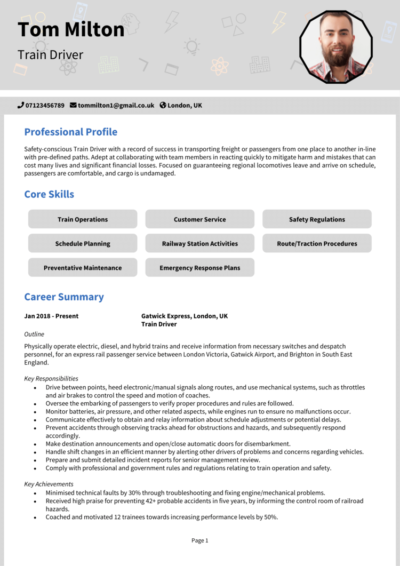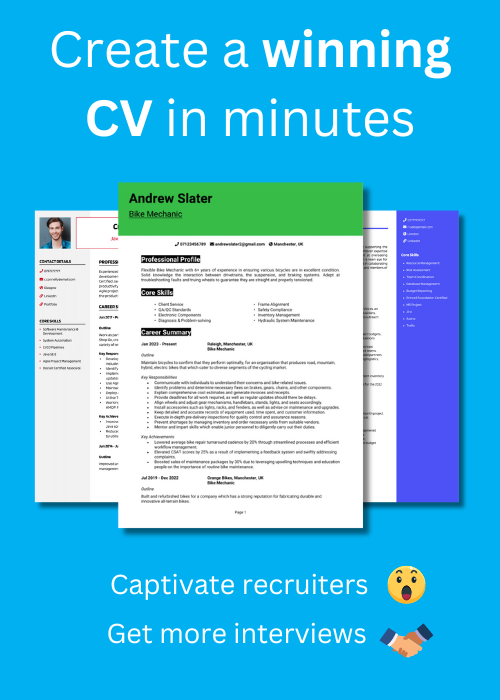Every train journey needs someone dependable at the controls: you’re the steady hand that literally keeps everything running on track.
This guide and its Train Driver CV example will help you present your experience and professionalism in a way that appeals to rail operators and shows you’re ready for the driver’s seat.
Train Driver CV sample
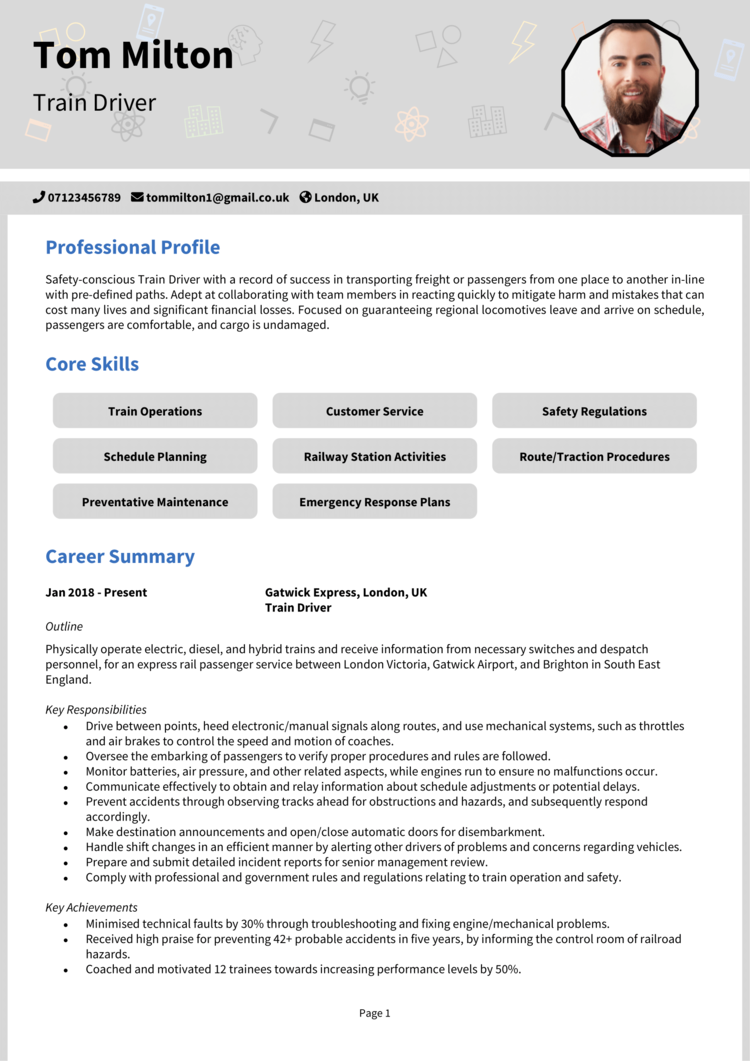
How to write your Train Driver CV
Discover how to craft a winning Train Driver CV that lands interviews with this simple step-by-step guide.
Writing a CV as a train driver isn’t about making bold claims – it’s about proving safety and consistency. The goal is to make it easy for recruiters to see your qualifications, technical knowledge, and ability to remain calm and focused under pressure.
This guide will walk you through the key steps to structure your experience clearly and highlight your competencies in order to create a CV that makes employers confident in your ability to operate safely and efficiently.
The best way to structure and format your Train Driver CV
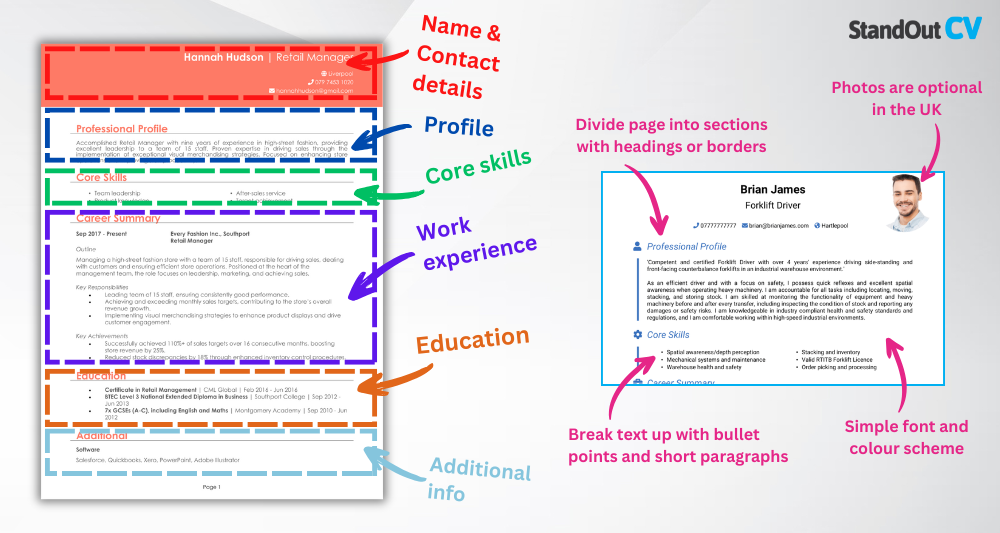
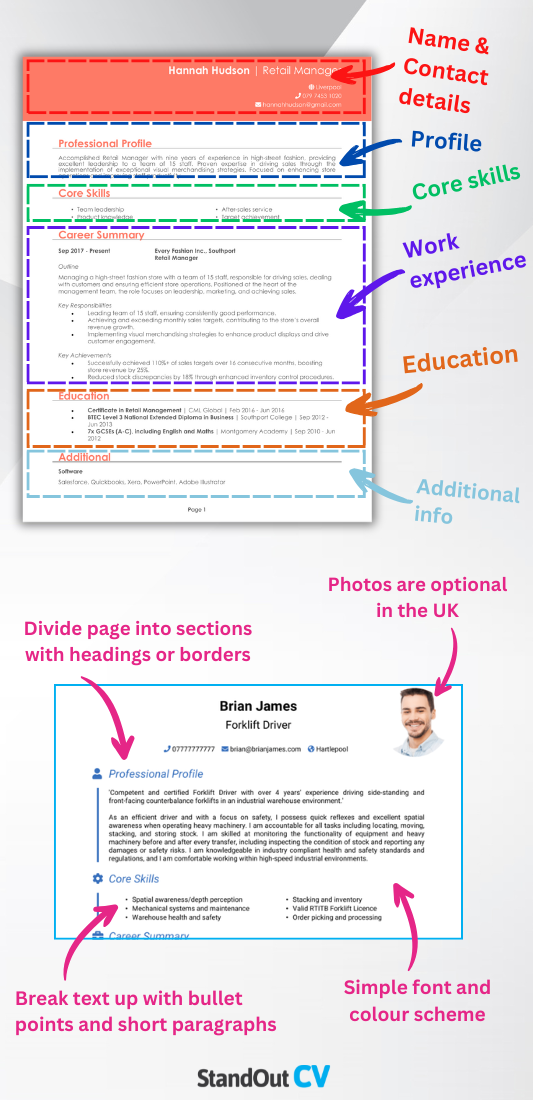
In the rail industry, there’s no room for error – and the same goes for your CV. A well-organised document makes it easy for hiring teams to understand your experience and proven strengths. Each section’s structure should be clear and effortlessly walk recruiters through the most important parts.
Here’s the layout to follow:
- Name and contact details – Display your personal details clearly at the top so employers can get in touch easily. Including a picture of yourslf is entirely optional.
- Profile – Begin with a concise summary that highlights your expertise and what you bring to the role.
- Core skills – Highlight your strongest skills that align with the role’s requirements.
- Work experience – Start with your most recent role and work backwards, showcasing achievements and responsibilities.
- Education & certifications – List qualifications and professional training relevant to rail work or a degree.
- Additional info – Include any additional details, like awards, professional memberships, or hobbies that highlight your skills or personality.
When it comes to your CV format, make sure to use bullet points to break up experience and responsibilities. Divide each section clearly with bold headings, and keep your CV clean and simple – using a readable font and no more than two pages in length. That’s ample length to get everything important across, so save any extra stuff for your cover letter. A tidy CV signals to employers that you value structure and clarity – key qualities for anyone in control of a train.
What is a Train Driver CV profile?


Your CV profile (or personal statement, for newer candidates) should give employers a quick sense of who you are as a driver – like your level of experience and how you approach the job. Whether you’ve been operating passenger services or freight lines, this is your chance to highlight your background and show that you’re a trustworthy, level-headed professional who will bring genuine value to the role.
Train Driver CV profile examples
Profile 1
Experienced and safety-conscious Train Driver with over seven years of experience operating passenger services across regional and high-speed networks. Skilled in route knowledge, timetable adherence, and fault reporting. Committed to ensuring the safe and punctual movement of trains while delivering a calm and professional presence for passengers. Fully qualified with up-to-date certification and a strong focus on rail safety standards.
Profile 2
Reliable Train Driver with five years of experience in urban and suburban rail services. Adept at operating electric and diesel units, communicating effectively with control teams, and managing delays or incidents calmly and efficiently. Demonstrates strong awareness of safety protocols, signal systems, and customer service during live operations.
Profile 3
Focused and dependable Train Driver with extensive knowledge of mainline routes and depot operations. Known for excellent concentration, punctuality, and adherence to operating procedures. Experienced in pre-departure checks, fault diagnosis, and liaising with maintenance teams. Passionate about upholding the highest standards of safety and performance across every journey.
Details to put in your Train Driver CV profile
Here’s what to include:
- Where you’ve worked – National rail operators, metro lines, depot work, or training programmes.
- Your top qualifications – Train Driver licence, PTS (Personal Track Safety), or safety-critical certification.
- Core attributes – Focused, dependable, rules-driven, able to stay calm under pressure.
- Type of routes or services – Passenger, freight, depot shunting, night services, etc.
- Work ethic – Commitment to punctuality, safety, and passenger welfare.
How to highlight your core skills


This section acts as a fast summary of the core abilities that make you a reliable and safe operator. Scan the job spec for the keywords you know recruiters are going to be looking for when they open up a CV, and prioritise those CV skills over generic soft skills.
Tailor this section to reflect the specific job you’re applying for: if you’ve worked on freight, night routes, or longer-distance services, those details can be reflected here in a way that helps you stand out.
Essential skills for a Train Driver CV
- Train Operation and Control – Safely operating trains according to schedules, signals, and speed limits across various routes.
- Route and Signal Familiarity – Understanding signalling systems, track layouts, and route-specific procedures to ensure smooth travel.
- Passenger Safety and Communication – Ensuring the safety of passengers by following protocols and providing clear announcements or updates.
- Pre-Departure Inspections – Conducting checks on braking systems, controls, and onboard equipment before each journey.
- Emergency Response and Incident Handling – Managing unexpected situations such as obstacles on the track or technical faults calmly and efficiently.
- Timekeeping and Schedule Adherence – Maintaining punctuality while balancing speed regulations and safety requirements.
- Regulatory Compliance – Following national rail safety standards, company procedures, and transportation laws.
- Technical Troubleshooting – Identifying and reporting mechanical or electrical issues and taking appropriate action.
- Fatigue and Risk Management – Managing rest periods and workload in line with strict safety and fatigue regulations.
- Communication with Control Centres – Liaising with signallers, controllers, and station staff to coordinate safe and timely operations.
How to showcase your work experience in your CV


This is where you prove you’ve done the job – and done it well. Rail employers want evidence of your ability to follow procedures, maintain focus for long shifts, and respond calmly in safety-critical situations. Each entry in your work experience section should reflect the trust and responsibility you’ve held.
List each role starting with the most recent. Include the job title, employer, and employment dates. Use bullet points to describe your key responsibilities and the impact of your work: a useful tip is to use numbers wherever possible to make your achievements feel more tangible.
How to format previous jobs in your CV correctly

- Outline – Describe the role and rail environment – e.g. operator, type of train, or service type.
- Responsibilities – Use action words like “operated,” “monitored,” “communicated,” or “followed.”
- Achievements – Mention outcomes such as “Maintained 98% on-time departure record,” “Passed all safety audits,” or “Trained two junior drivers during depot rotation.”
Example work history for Train Drivers
Train Driver | Midland City Rail
Outline
Operated passenger services on intercity and suburban routes, ensuring safe and timely departures in accordance with national rail operating standards.
Responsibilities
- Drove Class 170 and Class 222 units on scheduled routes across the Midlands and North.
- Completed daily safety inspections and pre-start checks before departure.
- Responded to on-track signals and communicated with control centres via GSM-R.
- Managed minor faults in service and followed escalation procedures as required.
- Assisted in safe boarding and platform announcements where necessary.
Achievements
- Maintained a 99% on-time record over 12-month reporting periods.
- Commended for professionalism during service disruption following signal failure.
- Trained two new drivers on route familiarisation and driving standards.
Train Driver | Northline Transport
Outline
Drove diesel and electric multiple units across rural and city routes, supporting reliable and safe transportation for daily commuters and long-distance passengers.
Responsibilities
- Operated rolling stock including Class 158 and Class 156 DMUs.
- Maintained full awareness of route conditions, speed restrictions, and signal layouts.
- Recorded journey data and reported operational issues to relevant departments.
- Worked closely with guards and on-board crew to support customer needs.
- Adhered strictly to fatigue management and rest period policies.
Achievements
- Recognised by line manager for 100% safety audit compliance.
- Consistently met all driver competency assessments and route tests.
- Supported reduced journey delays during engineering diversions through strong coordination.
Train Driver | East Seaboard Railways
Outline
Provided frontline train operation on busy commuter routes, ensuring safety, punctuality, and communication with control and passengers during live operations.
Responsibilities
- Conducted full cab inspections, brake tests, and readiness checks pre-departure.
- Monitored track signals and adhered to speed limits and route-specific instructions.
- Provided accurate updates during delays and supported resolution of on-board incidents.
- Collaborated with station staff and platform marshals to ensure safe departure protocols.
- Maintained up-to-date training on emergency evacuation and safeguarding protocols.
Achievements
- Achieved full qualification on five major routes within first year of employment.
- Responded effectively to two live faults, minimising disruption and ensuring passenger safety.
- Awarded ‘Driver of the Quarter’ for exceptional conduct and reliability under pressure.
Structuring your education section


For train driver roles, this section is vital. Start with your most recent or relevant qualification – such as a Train Driver licence or NVQ in Rail Transport. Follow with secondary education or any additional courses in safety, operations, or mechanical knowledge.
If you’re in training or recently qualified, include modules or competencies you’ve completed – like fault diagnosis or radio communications. Your certifications prove that you’re equipped to handle the safety demands of the role and that you’ve met the legal and professional standards to drive.
Top qualifications to showcase on a Train Driver CV
- Train Driver Licence (EU/UK Class B or equivalent) – Legally required to operate trains on mainline tracks.
- PTS (Personal Track Safety) Certificate – Demonstrates you’ve met safety standards for trackside work.
- NVQ Level 2/3 in Rail Transport Operations – Covers core competencies for working in rail environments.
- Operational Safety or Emergency Procedures Training – Validates your readiness for safety-critical scenarios.
- Full Clean UK Driving Licence – Often preferred for general suitability and familiarity with vehicle safety.


